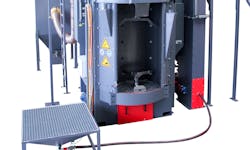De-Sanding, Deburring Aluminum Castings in Tight Spaces
RÖSLER developed an inline surface-treatment system for BMW Group’s Landshut, Germany aluminum foundry, for fully automated de-sanding and deburring of different version of stator carriers produced there. The RWK 6/12-2 swing-chamber blast machine is a compact, dual-chamber machine for shot-blast cleaning of the aluminum castings in a 50-second cycle time. The dual chamber concept and robotic loading/unloading significantly reduce the total for unproductive equipment time.
In the stator carrier manufacturing line, the RWK 6/12-2 – including a part-feeding system, robot, a blast media discharge station, and a small storage area – requires only 10-square meters of space.
The RWK can handle carriers with a height of up to 1,200 mm and a maximum diameter of 600 mm.
Workpieces arrive on a conveyor belt from the de-sanding station, where most of the molding and core sand has been removed from the castings. The robot, placed in front of the shot-blast machine, picks up one stator carrier at a time and places it on a special workpiece fixture in the chamber facing the load-unload zone. In case of a workpiece change the fixture can be exchanged within a few seconds.
During the casting process a data-matrix code is “imprinted” to the carrier, so to preserve this code from damage during the shot-blast operation it is protected with a cover. Rösler engineers developed a mechanism that automatically moves the protective cover over the code after the carrier has been placed on the fixture.
After completion of the loading stage the chamber turns by 180 degrees. This turn moves the chamber containing the unfinished part into the blast zone and the chamber containing a finished part into the load/unload zone. The robot removes the shot-blasted stator carrier, moves it to the media discharge station for shaking out residual blast media, and then places it into an intermediate storage location.
In this application, the foundry is using a zinc cut-wire blast media. The media is accelerated and thrown at the stator carriers by two Gamma 300G turbines with a drive power of 15 kW each. These high-performance turbines, developed by Rösler, are equipped with curved throwing blades in Y design. Compared to conventional turbines, the precisely calculated blade curvature generates a much higher media throwing speed. In turn, this results in up to 20 % higher shot-blast intensity and significantly lower energy consumption.
The high-blast intensity, combined with the dual chamber machine design, allows maximum cycle times of 50 seconds. Another benefit of the gamma turbines is that the special Y design of the throwing blades allows the use of both blade sides. This practically doubles their usable life. And, with a quick change system, the throwing blades can be replaced without having to dismount the turbine from the housing.
Because of the workpiece material (aluminum) and the blast media (zinc), the shot-blast machine had to be designed with special protection against explosions. This included special ducting for exhaust air and an explosion-protected dust collector.
Working with an automation specialist, Rösler engineers implemented a partial digitization of the shot-blast machine. For example, visualization of the shot-blasting operations and blast patterns of the two turbines allows changing the process parameters during the actual shot-blasting process. In addition, the operator can observe - “live” - which turbine is blasting on which workpiece section. If needed, he can initiate changes, reposition the workpiece in the blast chamber or modify the blast time. This may become necessary, for example, if a worn casting mold causes more sand to be deposited on a certain workpiece section than defined during the initial programming of the shot-blast machine.
Operating time is continuously monitored, too. After having reached a certain operating hour threshold, the machine automatically provides information about necessary controls and maintenance work, for example, for the throwing blades, workpiece fixtures or the protective cover for the matrix code. This helps minimize unplanned equipment down times and significantly increase the uptime of the machine -- especially important for the cost-efficiency of automated manufacturing lines. Learn more at www.rosler.com
